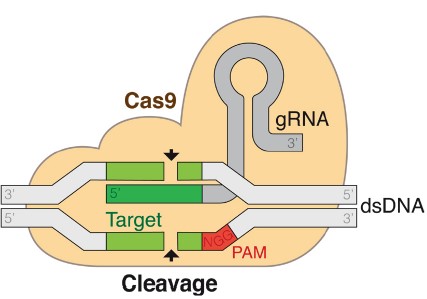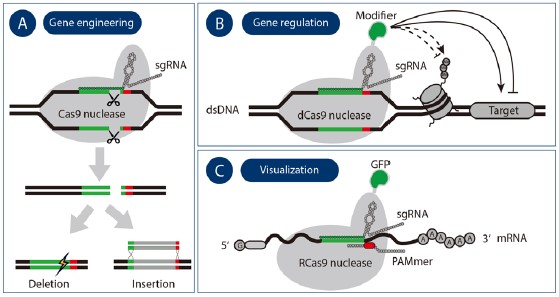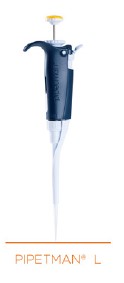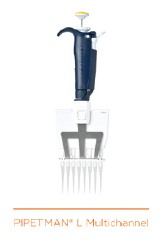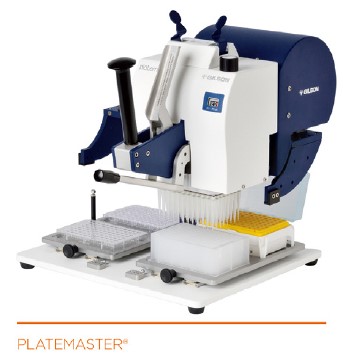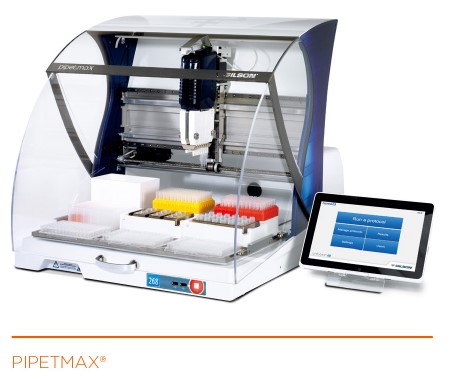Gilson의 'CRISPR/Cas9 Genetic Engineering - How Gilson Manual and Automated Pipetting Tools Facilitate the Process'를 이용한 응용자료는 한국분석기기(주)에서 제공하였으며 주요 내용은 다음과 같다.
BACKGROUND
CRISPR/Cas9 technology is a cutting-edge gene-engineering tool, that allows the rapid and precise editing of genetic sequences in a wide range of organisms. The Cas9 protein is an RNA-guided endonuclease that can introduce site-specific cleavage of double stranded DNA.1-3
This allows the alteration of genomic loci and the generation of gene knockouts(KO) or knock-ins in a straightforward and reliable way.
Recent advances in the field now also allow use of the system for epigenome editing; the fusion of a functional effector domain(e.g. a transcriptional or epigenetic modifier) to a nucleasedeficient Cas9 (known as dead Cas9 or dCas9), enables controlled transcriptional regulation of a targeted region.4
Using a nuclear-localized RNA-targeting Cas9 endonuclease (RCas9) it is now even possible to tag and track mRNA in live cells; this allows the real-time dynamics of gene expression to be investigated.5
Further exciting developments using catalytically inactive or “dead” Cas9(a variant bearing both the D10A and H840A mutations that does not cleave DNA) fused with a fluorescent protein allow the visualization of chromosome dynamics and genome architecture.6
Owing to its simple delivery and high efficiency, the CRISPR/Cas9 system can also be utilized for high-throughput genome-wide screens.7
Overall, the CRISPR/Cas9 system has revolutionized life science research and now holds great promise for biotechnology and therapeutic applications.8
The CRISPR/Cas9 system is a powerful and versatile tool for gene engineering, genome regulation and for the visualization of biological processes.
The system only requires two components: the Cas9 endonuclease, and a single guide RNA(sgRNA). The sgRNA is typically around 20 nucleotides long and guides the Cas9 endonuclease to its target sequence, which immediately follows a Protospacer Adjacent Motif(PAM).
PAMs are required for target binding and are unique to different Cas9 orthologues.9
Once at its target location, the Cas9 nuclease can cleave the DNA, manipulate gene expression, or label the region of interest (Figures 1 and 2).
Figure 1. The Cas9 nuclease/DNA/sgRNA complex.
Cas9 binds at a specific region on the dsDNA as a result of the single guide RNA molecule (sgRNA).
Cleavage occurs 3 base pairs upstream of the PAM sequence. Image by Mariuswalter - Own work, CC BY-SA 4.0,
https://commons.wikimedia.org/w/index.php?curid=62766587
Figure 2. Applications of CRISPR/Cas9 technology.
A) Schematic of Cas9 nuclease, guided by a sgRNA introducing a double strand break into the target sequence(Green), adjacent to PAM sequence(Red). Repair mechanisms such as non-homologous end joining result in deletions or insertions which can lead to a frameshift.
B) Nuclease-deficient Cas9 linked to a functional effector such as transcriptional or epigenetic modifiers can rapidly regulate gene expression.
C) RCas9 fused to a fluorescent reporter together with a sgRNA and a PAMmer allow live imaging of mRNA for visualization of gene expression.
Gilson provides scientists with a range of manual and automated high precision liquid handling tools to enable CRISPR/Cas9 gene editing research. By choosing the right tool for the right job, convenience, productivity, accuracy and precision can all be maximised to ensure reproducible and verifiable results.
THE CRISPR WORKFLOW
The essential steps in a typical CRISPR KO experiment are as follows:
1. Design of specific sgRNAs.
Which should be specific to the target sequence only, so as to avoid unintended off-target effects elsewhere in the genome.10-11 Importantly, given the ubiquitous presence of the PAM sequence(NGG) in most genomes, the system is able to operate in nearly every genomic region. For this reason many studies have used the CRISPR/Cas9 system for high-throughput genome-wide screens, using arrayed or pooled sgRNA libraries.12
2. Production of sgRNAs (Plasmid method).
The designed sgRNA have to be generated and cloned into expression plasmids. The generation of several sgRNAs per target and the validation of sgRNA activity is highly recommended to compare guide efficiencies, streamline experimental timelines and increase the chance of successful modifications.
In this labour intensive and repetitive step, the Gilson PIPETMAN®L and PIPETMAN®M range of manual and electronic pipettes are ideal to ensure maximal precision at the small volumes required for the cloning steps. Both the PIPETMAN® L and PIPETMAN®M are available in a range of volume sizes, and when used in conjunction with Gilson PIPETMAN tips, ensure optimal accuracy and precision for volumes as low as 0.2μL.
With single channel or multi-channel options available, any labware or throughput can be accommodated.
3. Delivery of CRISPR components.
A crucial step in the experimental pipeline is the efficient delivery of the CRISPR components to the cells.
The Cas9 endonuclease can be delivered as a purified recombinant protein or via a Cas9 expression plasmid, which can also encode the required sgRNA.
If Cas9 protein is used, the sgRNA can be either pre-complexed (as a ribonucleoprotein or ‘RNP’ complex13), or delivered on a separate sgRNA expression plasmid or as a PCR-based sgRNA amplicon containing an expression cassette.14 These components can then be introduced into the cells by a variety of approaches, including transfection, electroporation or viral delivery.
4. Cell culture.
Following successful delivery the CRISPR components clonal cell lines can be established.
Inside the cells the CRISPR-Cas system will repeatedly seek out the correct target sequence specified by the gRNA and once at this site, Cas9 will cleave both strands of DNA inducing a local DNA damage response.
In the case of a KO experiment, as non-homologous end joining can sometimes lead to imprecise repair in the form or insertions or deletions, the reading frame of a gene can be shifted such that it is no longer able to produce a functional protein.
The Gilson PIPETMAN®L Multichannel or electronic PIPETMAN®M Multichannel ranges make setting up multiple 96-well plates for clonal cell culture straightforward and fast, giving you the maximum probability of detecting your modification of interest.
Recent developments in the CRISPR-Cas9 field are enabling researchers to perform high throughput CRISPR screening experiments;11
However, with such large-scale workflows, manual sample preparation is often inefficient, time consuming and laborious.
The accuracy and intuitive operation of the Gilson PLATEMASTER® give researchers the ability to streamline the workflow of CRISPR/Cas9 studies at scale.
PLATEMASTER® is the ideal solution for performing 96-well or 384-well plate-to-plate transfers or for transferring buffers or media from a reservoir.
With zero programming, minimal set-up is required, and it’s small footprint makes it ideal to use in a laminar flow hood or cabinet.
For the sample preparation and qPCR validation of clones, the Gilson PIPETMAX® automated liquid handler removes the risk of manual error.
With its volume range from 1μL to 1mL, and the ability to use 1 to 8 pipetting tips at any one time, PIPETMAX® is the most versatile liquid handler for its size. PIPETMAX® can eliminate user to user error, as well as human error in sample transfers, while completing experiments unattended, leaving scientists more time to focus on more important tasks.
The ability to use 96- and 384-well plates, allows for increased throughput with sample tracking. PIPETMAX® uses the same tips as the manual Gilson pipettes so you can be assured of the same excellent performance.
5. Validation.
Once your clones are ready, a sample of the cells can be lysed and the target genomic region from each can be PCR amplified and sequenced.
There are a number of other useful techniques that can also be performed to detect whether or not the CRISPR gene-editing experiments have been successful, including T7E1 assay, surveyor assay, or next generation sequencing.14-15 Once knockout clones have been identified, they can be further expanded and the cellular phenotypes can be studied in detail.
In addition to the PIPETMAN®L and PIPETMAN®M manual and electronic pipettes, PIPETMAX® offers industry-leading accuracy and precision and is the perfect accompaniment for automating your qPCR validation experiments.
The Normalization Assistant, a software wizard, allows you to import your DNA concentrations: PIPETMAX automatically calculates the volumes required to be transferred to create your normalized plate. In addition, the qPCR Assistant, also a software wizard, helps you to set up your qPCR experiment exactly how you want it and keep track of track of numerous samples with ease.
Its flexibility allows you to create and store multiple experiments and use your preferred labware, while creating an output file that can be imported directly to your thermocycler.
SUMMARY
CRISPR/Cas9 is undoubtedly one of the most revolutionary tools in modern molecular biology with wide reaching applications for basic science, industry and healthcare.
Within only a few years after its initial discovery as a programmable gene-editing device, CRISPR/Cas9 has fast become the method of choice for genome engineering in many laboratories all over the world.
As with many techniques in modern molecular biology, CRISPR/ Cas9 workflows are dominated by pipetting, liquid handling and the complexing and delivery of key reagents.
Based on Gilson’s longstanding expertise in the development of liquid handling and laboratory automation, our products offer the high level of accuracy and precision required for all levels of a CRISPR/Cas experimental workflow.
Reference(참고문헌): Gilson Technical note TN213
1. Jinek M, Chylinski K, Fonfara I, Hauer M, Doudna JA, Charpentier E. A Programmable Dual-RNA - Guided. Endonuclease in Adaptive Bacterial Immunity. Science, 337, 816-822(2012).
2. Mali P, Yang L, Esvelt KM, Aach J, Guell M, DiCarlo JE, et al. RNA-Guided Human Genome Engineering via Cas9. Science, 339, 823-826(2013).
Available from: http://www.ncbi.nlm.nih.gov/pubmed/23287722
3. Cong L, Ran FA, Cox D, Lin S, Barretto R, Hsu PD, et al. Multiplex Genome Engineering Using CRISPR/Cas Systems. Science, 339, 819-823(2013).
4. Dominguez AA, Lim WA, Qi LS. Beyond editing:
repurposing CRISPR-Cas9 for precision genome regulation and interrogation. Nat. Rev. Mol. Cell Biol., 17, 5-15(2015).
Available from: http://www.ncbi.nlm.nih.gov/pubmed/26670017
5. Nelles DA, Fang MY, O’Connell MR, Xu JL, Markmiller SJ, Doudna JA, et al. Programmable RNA Tracking in Live Cells with CRISPR/Cas9. Cell, 165, 488-496(2016).
Available from: http://dx.doi.org/10.1016/j.cell.2016.02.054
6. Chen B, Gilbert LA, Cimini BA, Schnitzbauer J, Zhang W, Li GW, Park J, Blackburn EH, Weissman JS, Qi LS, Huang B Cell, 155, 1479-1491(2013).
7. Shalem O, Sanjana NE, Zhang F. High-throughput functional genomics using CRISPRCas9. Nat. Rev. Genet., 16, 299-311(2015).
Available from: http://www.pubmedcentral.nih.gov/articlerender.fcgi?artid=4503232&tool=pmcentrez&rendertype=abstract
8. Hsu PD, Lander ES, Zhang F. Development and applications of CRISPRCas9 for genome engineering. Cell, 157, 1262-1278(2014).
Available from: http://dx.doi.org/10.1016/j.cell.2014.05.010
9. Braff JL, Yaung SJ, Esvelt KM, Church GM. Characterization of Cas9 guide RNA orthologs. Cold Spring Harb. Protoc., 5, 422-425(2016).
10. Hsu PD, Scott DA, Weinstein JA, Ran FA, Konermann S, Agarwala V, et al. DNA targeting specificity of RNA-guided Cas9 nucleases. Nat. Biotechnol., 31, 827-832(2013).
Available from : https://www.ncbi.nlm.nih.gov/pmc/articles/PMC3969858/
11. Doench JG, Hartenian E, Graham DB, Tothova Z, Hegde M, Smith I, et al. Rational design of highly active sgRNAs for CRISPR-Cas9-mediated gene inactivation. Nat. Biotechnol., 32, 1262-1267 (2104).
Available from: http://www.pubmedcentral.nih.gov/articlerender.fcgi?artid=4262738&tool=pmcentrez&rendertype=abstract
12. Agrotis A, Ketteler R. A new age in functional genomics using CRISPR/Cas9 in arrayed library screening. Front. Genet., 6, 1-15 (2015).
13. Sojung Kim, Daesik Kim, Seung Woo Cho, Jungeun Kim and Jin-Soo Kim. Highly efficient RNA-guided genome editing in human cells via delivery of purified Cas9 ribonucleoproteins. Genome Research 24, 1012-1019,(2014). https://www.ncbi.nlm.nih.gov/pmc/articles/PMC4032847/pdf/1012.pdf
14. Ran FA, Hsu PD, Wright J, Agarwala V, Scott DA, Zhang F. Genome engineering using the CRISPR-Cas9 system. Nat. Protoc., 8, 2281-2308 (2013).
15. Qiu P, Shandilya H, D’Alessio JM, O’Connor K, Durocher J, Gerard GF. Mutation detection using SurveyorTM nuclease. Biotechniques, 36, 702-707 (2004).
ACKNOWLEDGEMENTS
The author would like to thank Chibeza Agley, Sarra Achouri, and J-rgen Fink from CamBioScience, Cambridge for hosting a series of CRISPR training courses this year and assisting with the writing of this Gilson Technical Note.
Gilson의 'CRISPR/Cas9 Genetic Engineering - How Gilson Manual and Automated Pipetting Tools Facilitate the Process'에 대한 궁금한 내용은 본 원고자료를 제공한 한국분석기기(주)를 통하여 확인할 수 있다.
Model Name(모델명): Pipetman L, Pipetman M, Plastmaster, Pipetmax
The Person in Charge(담당자): Hyesook An
Maker(제조사): Gilson.
Country of Origin(원산지): France(Pipetman), USA(Platemaster), Germany(Pipetmax)
e-mail: kaisco1@kaisco.co.kr
Data Services(자료제공): KAISCO.
<이 기사는 사이언스21 매거진 2020년 11월호에 게재 되었습니다.>



